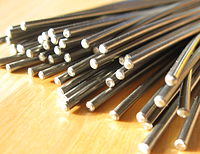
Photo from wikipedia
Crystal transformation between two polymorphs (green, 1-G, and red, 1-R) of the square-planar nickel complex NiL2 (L = 2-ethoxy-6-( N-methyliminomethyl)phenolate) and their tuning effect to semiconductor properties were studied both… Click to show full abstract
Crystal transformation between two polymorphs (green, 1-G, and red, 1-R) of the square-planar nickel complex NiL2 (L = 2-ethoxy-6-( N-methyliminomethyl)phenolate) and their tuning effect to semiconductor properties were studied both experimentally and theoretically. When 1-G is heated to 413 K, it converts to 1-R, whereas soaking 1-R in several kinds of solvents causes it to revert to 1-G. Crystallographic and PXRD studies reveal the dramatic changes in crystal dimensions due to the changes of packing models. Heating device made from 1-G (D-1-G(298)) at 413 K significantly increases the electrical conductivity from 6.55 × 10-4 S cm-1 for D-1-G(298) to 1.11 × 10-3 S cm-1 for D-1-G(413), showing significant crystal form dependence. Heat-treating D-1-G and D-1-R devices at different temperatures clearly reveals the reason for the conductivity tuning. Thus, the conductivity of NiL2-based devices could be well tuned through crystal transformation by heating or by soaking in solvent. Theoretical calculations clearly revealed the reason for such conductivity changes and also predicted that both polymorphs are good p-type semiconductors with hole mobilities of 1.63 × 10-2 (1-G) and 2.11 × 10-1 cm2 V-1 s-1 (1-R).
Journal Title: Inorganic chemistry
Year Published: 2018
Link to full text (if available)
Share on Social Media: Sign Up to like & get
recommendations!